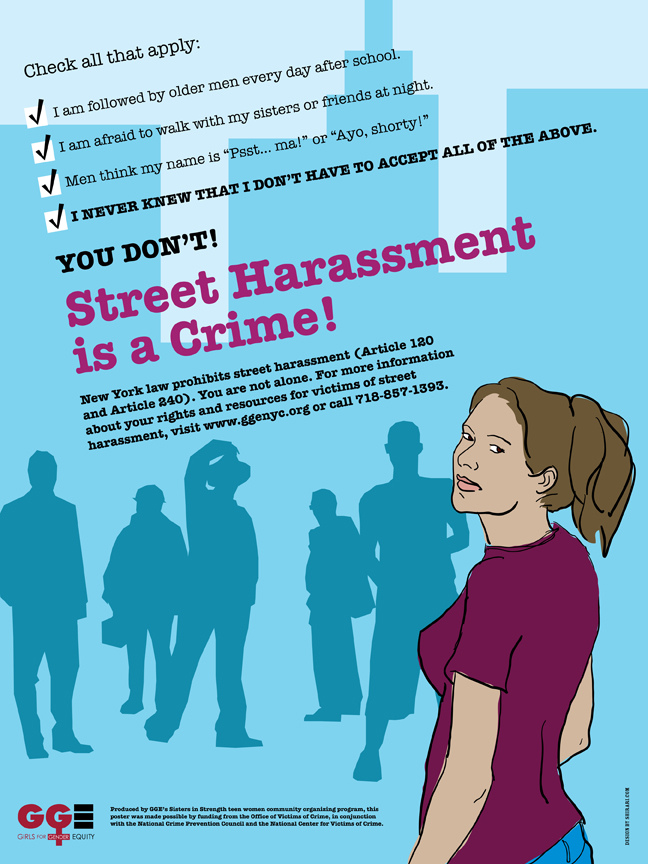Emily Gillingham, Washington, DC, USA, Blog Correspondent
 If you’re reading this, we’re probably on the same page that street harassment is awful. You’ve probably read about the toll that street harassment has on victims. If you study street harassment in the United States, you understand that there are a slew of laws covering every inch of the country designed to protect people from things like threatening language, upskirt photos, unwanted touching, being followed, obscene language, indecent exposure, and more. Penalties for violating those laws can include large fines or jail or prison time. But you also know that street harassment persists. It is pervasive. It directs where we go, what we do, the company we keep, and the clothes we wear.
If you’re reading this, we’re probably on the same page that street harassment is awful. You’ve probably read about the toll that street harassment has on victims. If you study street harassment in the United States, you understand that there are a slew of laws covering every inch of the country designed to protect people from things like threatening language, upskirt photos, unwanted touching, being followed, obscene language, indecent exposure, and more. Penalties for violating those laws can include large fines or jail or prison time. But you also know that street harassment persists. It is pervasive. It directs where we go, what we do, the company we keep, and the clothes we wear.
As a law student hoping to spend my career advocating for women, I think often about what public policy changes could address street harassment. Clearly, there are laws meant to protect victims of street harassment on the books. But I can say that I have no confidence that those laws would protect me from the run-of-the-mill sexual and harassing remarks hurled at me as I commute to and from work, even if a man hissed “hey baby” at me in earshot of a police officer. If I were to videotape an incident of street harassment I’d put my physical safety, personal property, and others around me at risk, with little expectation that the police would take my report seriously or bring the harasser to justice. If I were groped on the Metro, I would not expect bystanders to assist me and logistically could not fathom how I would ensure the perpetrator’s arrest and prosecution short of taping the incident and then cold-cocking him. Make no mistake: this is why these things continue to happen.
I don’t think that stopping street harassment can be solved by legislating against harassing behaviors. But I do think that progress lies in stressing the importance and attainability of street harassment reform to policymakers. If politicians, public health advocates, and nonprofits were to zealously pursue the following package of reforms, real progress will be made in eradicating street harassment.
Legislative, Legal, and Judicial Reforms
Laws should be comprehensive designed to keep up with new technology. Legislatures should pass well-drafted laws barring upskirt photos and other harassment with technology. State and federal evidentiary rules should be updated to ensure that electronic evidence of stalking and recordings made with digital recorders and cell phones are admissible into evidence when vetted properly. State bar associations should continue to expand training offered to attorneys and judges about how to obtain and preserve electronic evidence of stalking and street harassment in an admissible format.
Education
Education about street harassment is crucial; it can prevent people from becoming street harassers, better equip stakeholders to respond effectively to street harassment incidents, and change cultural attitudes that treat street harassment as a minor problem or no problem at all. School curricula should include age-appropriate education about respect for others, scientifically-rooted information about how being harassed is harmful to mental health, and safe means of responding to street harassment incidents they witness. School honor codes should explicitly state the school’s opposition to street harassment and describe penalties for students who engage in street harassment. College and university honor codes should reflect the same, and new student orientation should emphasize why street harassment is unacceptable and that harassment on-campus will not be tolerated.
Police officers and transit employees should be trained about street harassment laws and encouraged to take incidents reported to them seriously. Efforts should be made to teach the public how to report officials who fail to respond effectively to reports of street harassment.
Most importantly, nationwide movements encouraging bystander awareness in other areas should be built upon in the street harassment context. PSAs and other means of educating the public should be engaged to encourage bystanders to intervene when they witness street harassment incidents. They should stress why bystander intervention is important and describe effective strategies that bystanders can employ.
Funding
This is the most critical piece. Funding is why many reports of street harassment cannot be properly addressed and why public education about street harassment is so lacking. Funds should be allocated to build cybercrime units to take seriously the taking and distribution of upskirt photos- both to remove the content and to identify perpetrators and hold them accountable. Lawmakers need to earmark funds for street harassment prevention and prosecution, and tie funding for public safety, public health, and public transit to meeting benchmarks for street harassment training, education, and enforcement efforts. These proposals aren’t costly, but they won’t work without clearly defined benchmarks and penalties for failure to meet them.
Street harassment is a cultural problem and public health issue worthy of being prioritized in our public policy in these ways. Let’s hope that our policymakers start to see it this way too, to make our streets and public transportation safe and welcoming for everyone.
Emily is a 3L at Michigan State University College of Law, and the president of her school’s chapter of LSRJ. Follow her on Twitter @emgillingham.
